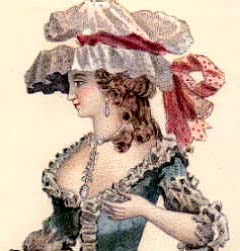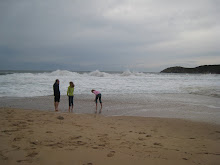 We docked in Ajaccio at about seven a.m. last Thursday morning after what was, at least in our minds, a rough crossing. I am not a boat person, it turns out. I used to think I was. I was mistaken. In the middle of the night C and I both woke up when the boat's tossing suddenly tossed my toiletries from the shelf at the end of the bunks up into the air and upside down onto the floor. Certainly my fault for having left it unzipped...but nevertheless. Life is uncertain enough without air born bottles of lotion in the wee hours.
We docked in Ajaccio at about seven a.m. last Thursday morning after what was, at least in our minds, a rough crossing. I am not a boat person, it turns out. I used to think I was. I was mistaken. In the middle of the night C and I both woke up when the boat's tossing suddenly tossed my toiletries from the shelf at the end of the bunks up into the air and upside down onto the floor. Certainly my fault for having left it unzipped...but nevertheless. Life is uncertain enough without air born bottles of lotion in the wee hours.We passed a couple of hours walking around in Ajaccio and taking in the street market, which was just setting up, and the statues of Napoleon, Ajaccio's favorite son, which were plentiful and without exception generic. When the first dose of caffeine began to wear off, we stopped in a bakery for coffee and pastries and whiled away the time until the Maison de Napoléon opened.
I spent eight years studying the French Revolution, and, though the Revolution left plenty of intangible monuments (the metric system; the rigid division of church and state in France), it left precious few monuments. The revolutionaries were too busy reimagining the world and doing away with the aristocracy to have leisure or funds to put up buildings. And so when, in our travels, we come anywhere near a site that has some clear connection to the years immediately after 1789, we make a detour so that I can take it in. That's why we began our Corsican trip in Ajaccio: I wanted to pay my respects to Napoleon.
The world and history being what it is, there is almost nothing original in the house where Napoleon was born: his family didn't even live in most of it during his lifetime, and he himself passed little time there. Nevertheless, city fathers being what they are, the house has a large stone plaque over the front door, claiming itself as Napoleon's birthplace, and the inside is a museum. Since there aren't any Napoleon artifacts to speak of, some clever curator has filled the house with an exhibition on the Bonaparte family and Napoleon's life before he became Emperor, a few rooms on the history of the house itself, and--hang in there, I'm getting to the good part--a collection of Weird Napoleonic Memorabilia. (That's not what it's called.)
So we worked our way through Napoleon's early life and Bonaparte family history. I found a copy of Louis XVI's signed order for Napoleon's army commission in 1791, and showed it to the girls--see the king's signature? see the signature of the king's secretary? later that family emigrated to New York and ran a dairy farm (I'm either a really good person to see a history museum with, or a really bad person, depending on your history threshold)--and we admired the collection of family portraits in miniature. Then came the wallpaper room--bits of wallpaper that used to be on the walls in the house--which did not take C and the girls terribly long to peruse. Finally we descended one more level and got to the Memorabilia room.
Even that was only mildly interesting: Napoleon III and Empress Eugénie stopped in during their rule, and there were a number of bits and pieces commemorating their visit. Then a copy of the laurel wreath that Napoleon commissioned when he wanted to dress up as a Roman emperor. Then we came round a corner and saw it: the Bonaparte family tree.
Done in Bonaparte family hair.
The label (I copied it into my notebook) read:
Arbre généalogique en cheveux de la famille Buonaparte (family tree in Bonaparte family hair)
cheveux et papier découpé et peinte (made of hair, cut paper and paint)etiquette manuscrite (with a handwritten label) :
fait par moi Elise, fille du docteur Polazzi, Corte (made by me, Elise, the daughter of Doctor Polazzi, in Corte).The piece dated from the 1850s. It was large--a couple of feet in height--and impressively detailed, showing all the descendants of all of Napoleon's siblings, their husbands and wives. Each branch of the tree was labeled in carefully elegant schoolgirl handwriting, with lots of swirls and curls, and each branch was made of human hair. (If you're wondering, all the Bonapartes seem to have been brunettes.) It was mounted on heavy paper and framed in a suitably Victorian gilded wooden frame.
C and the girls were appalled. I believe that the word 'gross' might have been used. They took a perfunctory look at the death mask, just around the corner, and then headed downstairs to the collection of exhibition posters from the 1990s. I stayed in front of the family tree.
Sometime in my schooling, someone taught me that the best way into the past is not by the front door with all the wars and great men but through the window in the second best bedroom, the one that only gets opened up when the first guest room is already full, and maybe the important guest has brought along an insignificant cousin who needs putting up. Or else it's the bedroom that the unmarried daughter uses, the one who stays up late reading god knows what. It's through that window--through what seems strange and unfamiliar and even bizarre--that we can find things that make history come alive, that make history matter. This family tree made out of hair was absolutely the window in through the second best bedroom.
I imagined Elise, the bourgeois doctor's daughter, in her father's house in Corte. None of Corsica is really on the beaten path, but Corte is in the center of the island. In the middle of the 1800s, you would have had to take several overgrown paths just to get there. But her father was the local doctor, so the family probably had some status. Maybe her father had treated someone who knew one of the Bonapartes, and so she wrote a letter and explained that she wanted to do something to honor the great son of Corsica and his family, and, do you think you could send me a few hanks of hair? And then: one day the hair arrived. Did it come by post, on a donkey? Or did someone who was visiting Corte bring it from Ajaccio? How long did it take Elise to make the tree? And once it was finished, did it sit on an easel in the family's front room, to be commented on when company came to call?
And what did Elise do afterwards? Did she stay in Corte? Did she open a business making and selling arbres généalogiques en cheveux? I don't know, and it would be hard to find out. Here's what I can say, though: this tree took Elise a long time to make. She had to make sketches, she had to practice working with the hair (all right, it's a little icky for us, that part), she had to find the right sort of backing paper and the right sort of wax to use on the hair. This was creative work that took time and patience. The Bonapartes must have mattered to her. Napoleon must have mattered to her: this little swarthy Ajaccian who went off on a boat one day and conquered almost all of Europe before he started losing battles and was disgraced and sent off to die on another island. But he and his family mattered to Elise, a generation later in her father's house in Corte. She wanted to be connected to that story, so she made this family tree.
Now it hangs in the Maison de Napoléon, and she is part of the museum's story, and, now, after I went on about it to my family for an hour or two, and bought postcards of it and sent them to my girlfriends, she's part of ours, too. We'll all forget the wallpaper samples, but this bizarre testament to Napoleon's island legend will stick with us.
What we'll remember about Napoleon's house is not so much Napoleon himself as young Elise from Corte, bending over her work in the second best bedroom. She sets her work table in front of the window, where the light is best, and maybe she hums a little while she separates the strands into smaller and smaller bits, designing first trunk, then branches, then twigs.
What we'll remember about Napoleon's house is not so much Napoleon himself as young Elise from Corte, bending over her work in the second best bedroom. She sets her work table in front of the window, where the light is best, and maybe she hums a little while she separates the strands into smaller and smaller bits, designing first trunk, then branches, then twigs.






































No comments:
Post a Comment